A Study of Aircraft Wake Vortices at Hong Kong International Airport Using Short-Range LIDAR
Abstract
1. Introduction
2. Materials and Methods
2.1. Equipment
2.2. First Period: Determination of Wake Vortex Location and Data Analysis
- (1)
- The Doppler velocity range, which is the difference between the maximum and the minimum Doppler velocities of a fixed gate (an example is given in Figure 2a), with the minimum Doppler velocity range fine-tuned to approximately 2.5 m/s.
- (2)
- The comparison between the maximum/minimum Doppler velocity and the velocity values of the adjacent radial gates along the same radial line, as well as those at the gates of the adjacent elevation angles (the so-called rays). The algorithm for this procedure is schematically illustrated in Figure 2b. A threshold was determined for the difference in Doppler velocities based on statistical analysis. Parameters relevant to the wake vortex that were identified were also considered, such as the separation between the pair of counter-rotating vortices and the height difference between the points of maximum and minimum Doppler velocities (both associated with the same vortex), with tunable thresholds for these parameters based on statistics.
2.3. Second Period: Aircraft-Specific EDR Analysis
2.4. Determination of Wake Vortex Lifetime
2.5. Correlation Analysis
- Background radial velocity, calculated by averaging radial velocity gates with ranges from 100 m to 850 m in the SR-LIDAR RHI scan. To avoid unrealistic values due to noise or clutter, the radial velocities in range were sorted, and the top and bottom hundred values were removed before performing the averaging. Due to the geometry of the RHI scan, it also represents the background crosswind.
- Maximum radial velocity difference between the extrema of the vortices and the background radial velocity.
- Relative humidity measured by a radiometer installed on HKIA, at a distance of approximately 6 km to the east/south-east of SRL-R3W. The mean value of relative humidity at the surface and at 118 m high is taken as the relative humidity at the typical height of vortices.
- Instability, taken as the difference between the temperature reading from a transmissometer near the R3W site at around 10 m high and the temperature at 118 m high measured by the radiometer.
3. Results and Discussion
3.1. Detection and Analysis of Wake Vortices Encounter
3.2. Wake Vortex Lifetime and Influencing Factors
3.3. Background Wind Measurements
3.4. Dimensionless Analysis of Wake Vortex Lifetime Against EDR and Comparison with Previous Results
4. Conclusions
Author Contributions
Funding
Institutional Review Board Statement
Informed Consent Statement
Data Availability Statement
Conflicts of Interest
Abbreviations
| CAD | Civil Aviation Department |
| HKIA | Hong Kong International Airport |
| EDR | Eddy Dissipation Rate |
| ICAO | International Civil Aviation Organization |
| LIDAR | Light Detection and Ranging |
| RECAT-EU | European Wake Turbulence Categorisation and Separation Minima on Approach and Departure |
| RHI | Range Height Indicator |
| SR-LIDAR | Short-range LIDAR |
References
- Federal Aviation Administration (FAA). Aircraft Wake Turbulence; AC 90-23G; U.S. Department of Transportation: Washington, DC, USA, 2014.
- Hallock, J.N. Aircraft Wake Vortices: An Assessment of the Current Situation; U.S. Department of Transportation Report, DOT-FAA-RD-90; U.S.; Department of Transportation: Washington, DC, USA, 1991.
- Hallock, J.N.; Holzäpfel, F. A Review of Recent Wake Vortex Research for Increasing Airport Capacity. Prog. Aerosp. Sci. 2018, 98, 27–36. [Google Scholar] [CrossRef]
- Gerz, T.; Holzäpfel, F.; Darracq, D. Commercial aircraft wake vortices. Prog. Aerosp. Sci. 2002, 38, 181–208. [Google Scholar] [CrossRef]
- Breitsamter, C. Wake vortex characteristics of transport aircraft. Prog. Aerosp. Sci. 2011, 47, 89–134. [Google Scholar] [CrossRef]
- International Civil Aviation Organisation (ICAO). Doc 4444, Procedures for Air Navigation Services—Air Traffic Management; International Civil Aviation Organisation (ICAO): Montreal, QC, Canada, 2016. [Google Scholar]
- Holzäpfel, F.; Strauss, L.; Schwarz, C. Assessment of Dynamic Pairwise Wake Vortex Separations for Approach and Landing at Vienna Airport. Aerosp. Sci. Technol. 2021, 112, 106618. [Google Scholar] [CrossRef]
- Zhang, C.; Pan, W.; Zhu, Y.; Jiang, Y.; Wang, X. Theoretical Assessment of Runway Capacity for Training and Transport Airport Considering Wake Vortex Encounter Safety: A Case Study of Luoyang Beijiao Airport. Appl. Sci. 2025, 15, 11273. [Google Scholar] [CrossRef]
- Brandon, J.M.; Jordan, F.L., Jr.; Stuever, R.A.; Buttrill, C.W. Application of Wind Tunnel Free-Flight Technique for Wake Vortex Encounters; No. NAS 1.60: 3672; NASA Center for AeroSpace Information: Linthicum Heights, MD, USA, 1997. [Google Scholar]
- Barbaresco, F.; Wasselin, J.P.; Jeantet, A.; Meier, U. Wake vortex profiling by Doppler X-band radar: Orly trials at initial take-off and ILS interception critical areas. In Proceedings of the Radar Conference, Rome, Italy, 26–30 May 2008; Institute of Electrical and Electronics Engineers: New York, NY, USA, 2008. [Google Scholar] [CrossRef]
- Köpp, F.; Rahm, S.; Smalikho, I.N. Characterization of aircraft wake vortices by 2-µ m pulsed doppler lidar. J. Atmos. Ocean. Technol. 2004, 21, 194–206. [Google Scholar] [CrossRef]
- Smalikho, I.N.; Banakh, V.; Holzäpfel, F.; Rahm, S. Method of radial velocities for the estimation of aircraft wake vortex parameters from data measured by coherent doppler lidar. Opt. Express 2015, 23, A1194–A1207. [Google Scholar] [CrossRef]
- George, R.; Yang, J. A Survey for Methods of Detecting Aircraft Vortices. In Proceedings of the 24th Conference on Mechanical Vibration and Noise, Chicago, IL, USA, 12–15 August 2012; pp. 14–50. [Google Scholar] [CrossRef]
- Kovalev, D.A.; Vanhoenacker-Janvier, D.; Billuart, P.; Duponcheel, M.; Winckelmans, G. Modeling of Wake Vortex Radar Detection in Clear Air Using Large-Eddy Simulation. J. Atmos. Oceanic Technol. 2019, 36, 2045–2062. [Google Scholar] [CrossRef]
- Zhang, Z.; Li, D.; Zhou, J.; Pan, W.; Xu, Z.; Cai, J. Numerical simulation of wake vortex for the flight near the ground with different boundary conditions. Eng. Appl. Comput. Fluid Mech. 2022, 16, 484–500. [Google Scholar] [CrossRef]
- Ahmad, N.N.; Proctor, F. Review of Idealized Aircraft Wake Vortex Models. In Proceedings of the 52nd Aerospace Sciences Meeting, National Harbor, MA, USA, 13–17 January 2014. [Google Scholar]
- Hennemann, I.; Holzäpfel, F. Large-eddy simulation of aircraft wake vortex deformation and topology. Proc. Inst. Mech. Eng. 2011, 225, 1336–1350. [Google Scholar] [CrossRef]
- Vechtel, D.; Stephan, A.; Holzäpfel, F. Simulation Study of Severity and Mitigation of Wake-Vortex Encounters in Ground Proximity. J. Aircr. 2017, 54, 1802–1813. [Google Scholar] [CrossRef]
- Yuan, J.; Liu, J.; Li, C.; Zhao, Z. Numerical Study of Aircraft Wake Vortex Evolution under the Influence of Vertical Winds. Appl. Sci. 2024, 14, 86. [Google Scholar] [CrossRef]
- Carvalho, G.F.M.d.; Vidille, M.F.; Bimbato, A.M.; Alcântara Pereira, L.A. Lagrangian Vortices Interactions Using Large-Eddy Simulation (LES) and Surface Roughness Model—Application for Aircraft Wake Vortices with Crosswind. Appl. Sci. 2023, 13, 12336. [Google Scholar] [CrossRef]
- Duró, J.M.; Bergadà, J.M. Airplane Vortices Evolution Near Ground. Appl. Sci. 2021, 11, 457. [Google Scholar] [CrossRef]
- Pan, W.; Yin, H.; Leng, Y.; Zhang, X. Recognition of Aircraft Wake Vortex Based on Random Forest. IEEE Access 2022, 10, 8916–8923. [Google Scholar] [CrossRef]
- Niklas, W.; Stephan, A.; Holzäpfel, F.; Rotshteyn, G. Characterizing aircraft wake vortex position and strength using LiDAR measurements processed with artificial neural networks. Opt. Express 2022, 30, 13197–13225. [Google Scholar] [CrossRef]
- Ma, Y.; Tang, X.; Shi, Y.; Chan, P.-W. YOLOv8n–CBAM–EfficientNetV2 Model for Aircraft Wake Recognition. Appl. Sci. 2024, 14, 7754. [Google Scholar] [CrossRef]
- Wartha, N.; Stephan, A.; Holzäpfel, F. Wake vortex lidar measurement processing with large-eddy simulations and machine learning. Opt. Express 2025, 33, 26473–26498. [Google Scholar] [CrossRef] [PubMed]
- Aziz, A.; Mohammad, A. Automatic Recognition of Airliners Wake Turbulence Using Various Tech-niques of Machine Intelligence. Results Eng. 2024, 23, 102624. [Google Scholar] [CrossRef]
- Rooseleer, F.; Treve, V. RECAT-EU—European Proposal for Revised Wake Turbulence Categorisation and Separation Minima on Approach and Departure; Eurocontrol Technical Report; Eurocontrol: Brussels, Belgium, 2013; p. 32. [Google Scholar]
- Hon, K.K.; Chan, P.W. Aircraft Wake Vortex Observations in Hong Kong. J. Radars 2017, 6, 709–718. [Google Scholar] [CrossRef]
- Hon, K.K.; Chan, P.W.; Chim, K.C.Y.; De Visscher, I.; Thobois, L.; Rooseleer, F.; Troiville, A. Wake Vortex Measurements at the Hong Kong International Airport. In Proceedings of the AIAA SCITECH 2022 Forum, San Diego, CA, USA, 3–7 January 2022. [Google Scholar] [CrossRef]
- Civil Aviation Department (CAD). Aeronautical Information Publication, ENR 1.6. CAD, HKSARG. 2025. Available online: https://www.ais.gov.hk (accessed on 12 November 2025).
- Wu, S.; Zhai, X.; Liu, B. Aircraft Wake Vortex and Turbulence Measurement Under near-Ground Effect Using Coherent Doppler Lidar. Opt. Express 2019, 27, 1142–1163. [Google Scholar] [CrossRef] [PubMed]
- Chan, P.W. Generation of an Eddy Dissipation Rate Map at the Hong Kong International Airport Based on Doppler Lidar Data. J. Atmos. Ocean. Technol. 2011, 28, 37–49. [Google Scholar] [CrossRef]
- Holzäpfel, F. Analysis of potential wake vortex encounters at a major European airport. Aircr. Eng. Aerosp. Technol. Int. J. 2017, 89, 634–643. [Google Scholar] [CrossRef]
- Burnham, D.C.; Hallock, J.N. Wind Effects on the Lateral Motion of Wake Vortices; DOT/FAA/AAR-99/DOT; Volpe National Transportation Systems Center: Cambridge, MA, USA, 1999. [Google Scholar]
- Holzäpfel, F.; Steen, M. Aircraft wake-vortex evolution in ground proximity: Analysis and parameterization. Am. Inst. Aeronaut. Astronaut. J. 2007, 45, 218–227. [Google Scholar] [CrossRef]
- Wassaf, H.S.; Wang, F.Y.; Soares, M. Atmospheric Turbulence Effects on Near-Ground Wake Vortex Demise. In Proceedings of the American Meteorological Society 13th Conference on Aviation, Range, and Aerospace Meteorology, New Orleans, LA, USA, 21–24 January 2008. [Google Scholar]
- Sarpkaya, T.; Robins, R.E.; Delisi, D.P. Wake-Vortex Eddy-Dissipation Model Predictions Compared with Observations. J. Aircr. 2001, 38, 687–692. [Google Scholar] [CrossRef]
- Ma, Y.; Zhao, J.; Han, H.; Chan, P.W.; Xiong, X. Aircraft Wake Recognition Based on Improved ParNet Convolutional Neural Network. Appl. Sci. 2023, 13, 3560. [Google Scholar] [CrossRef]

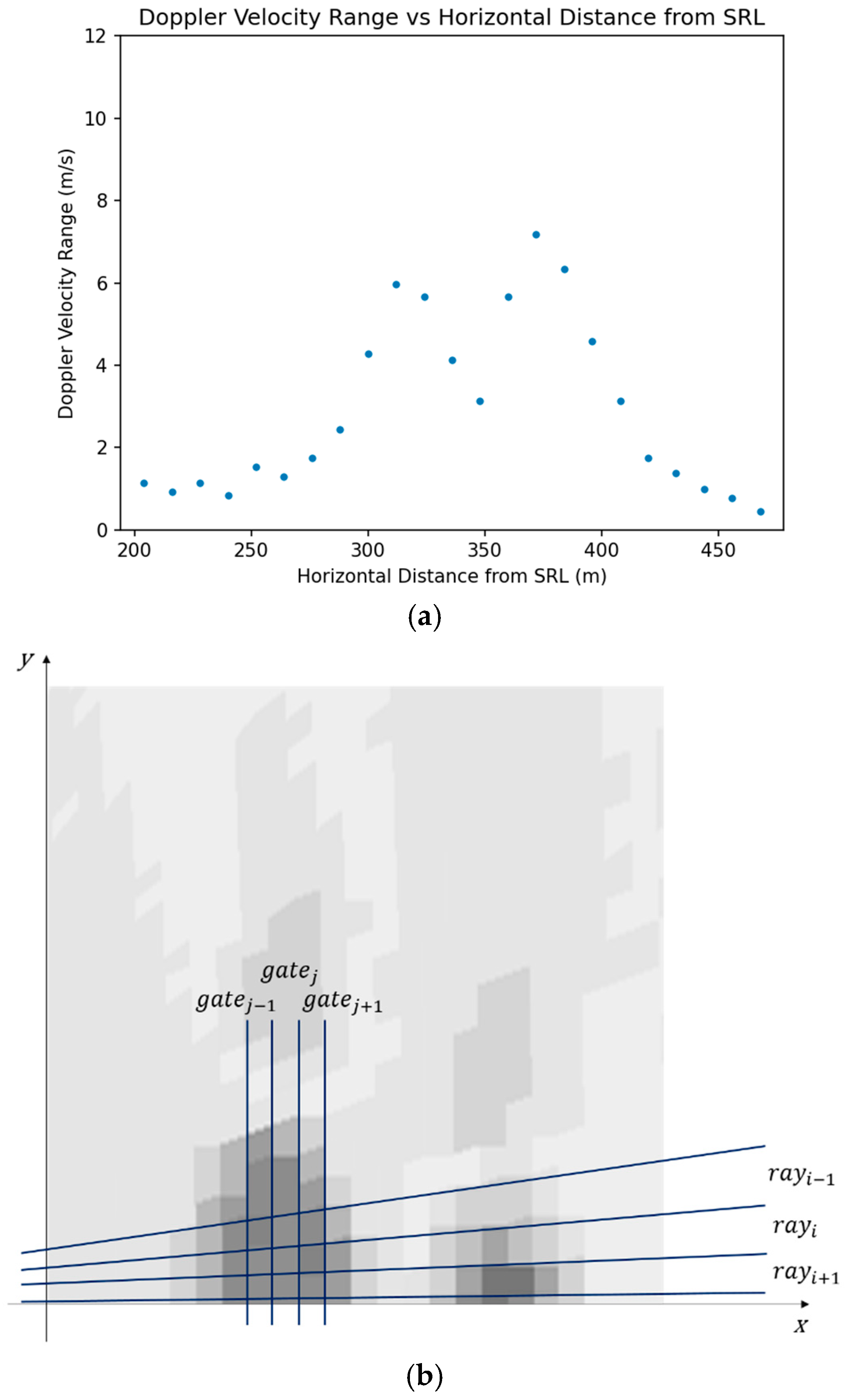

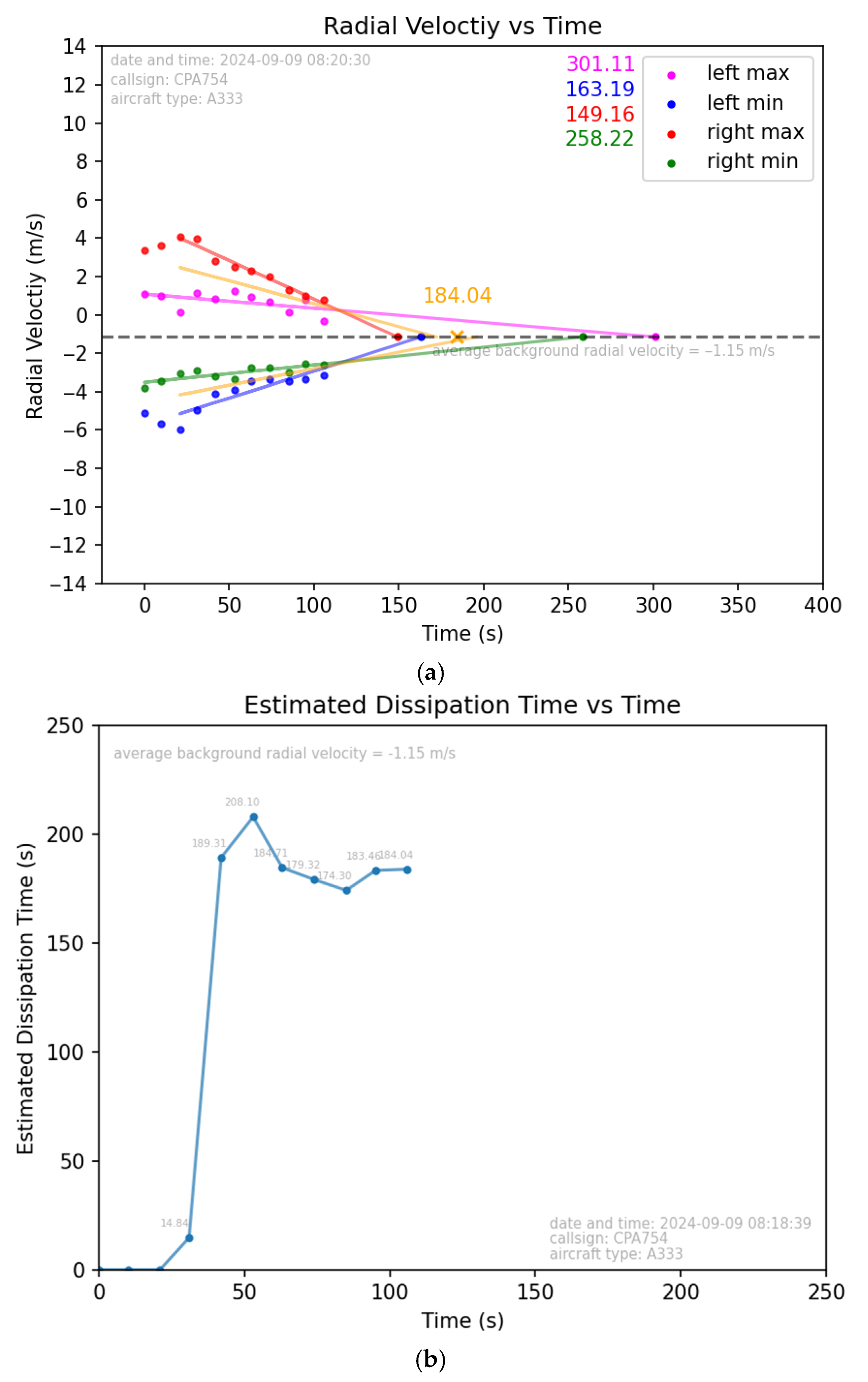
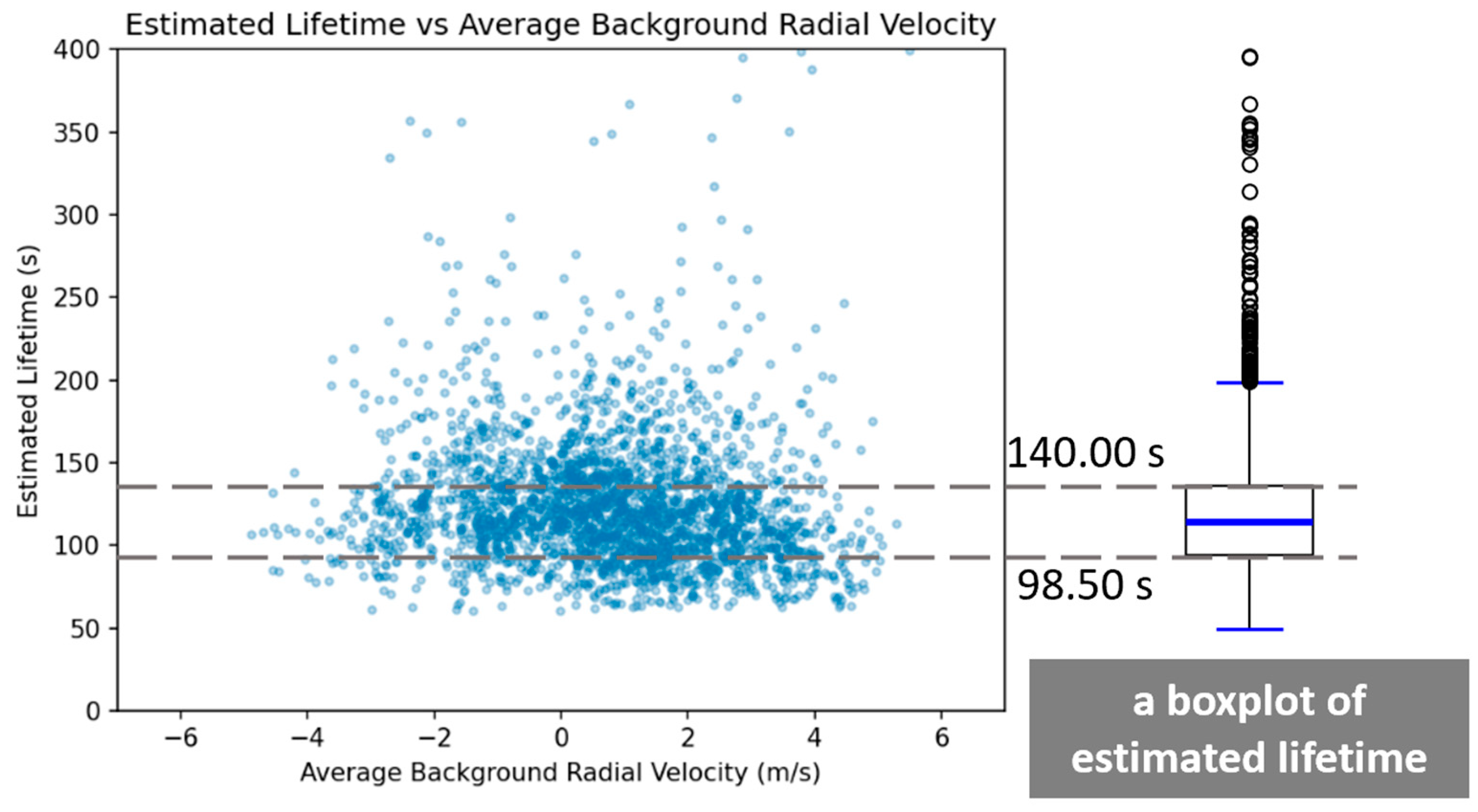

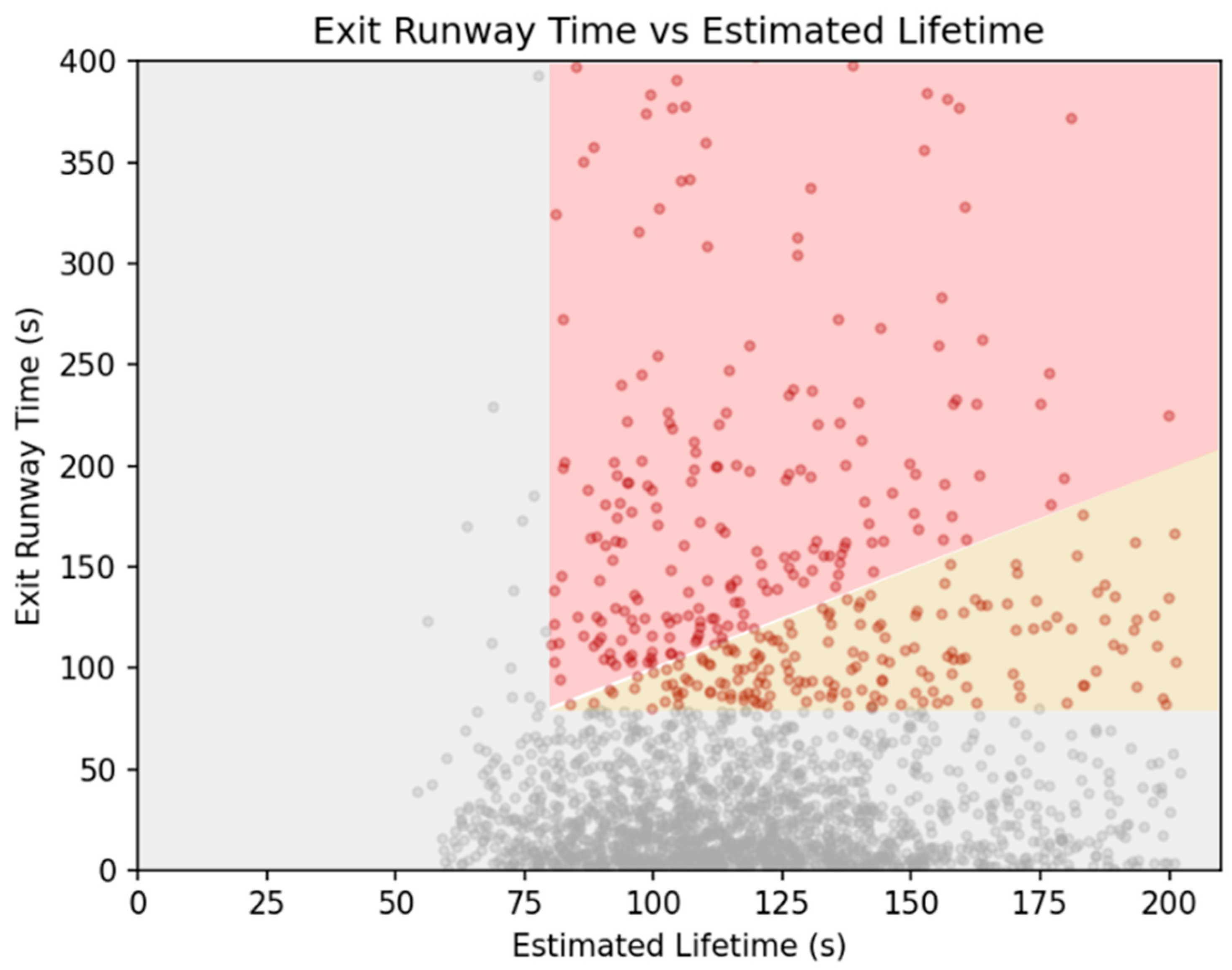
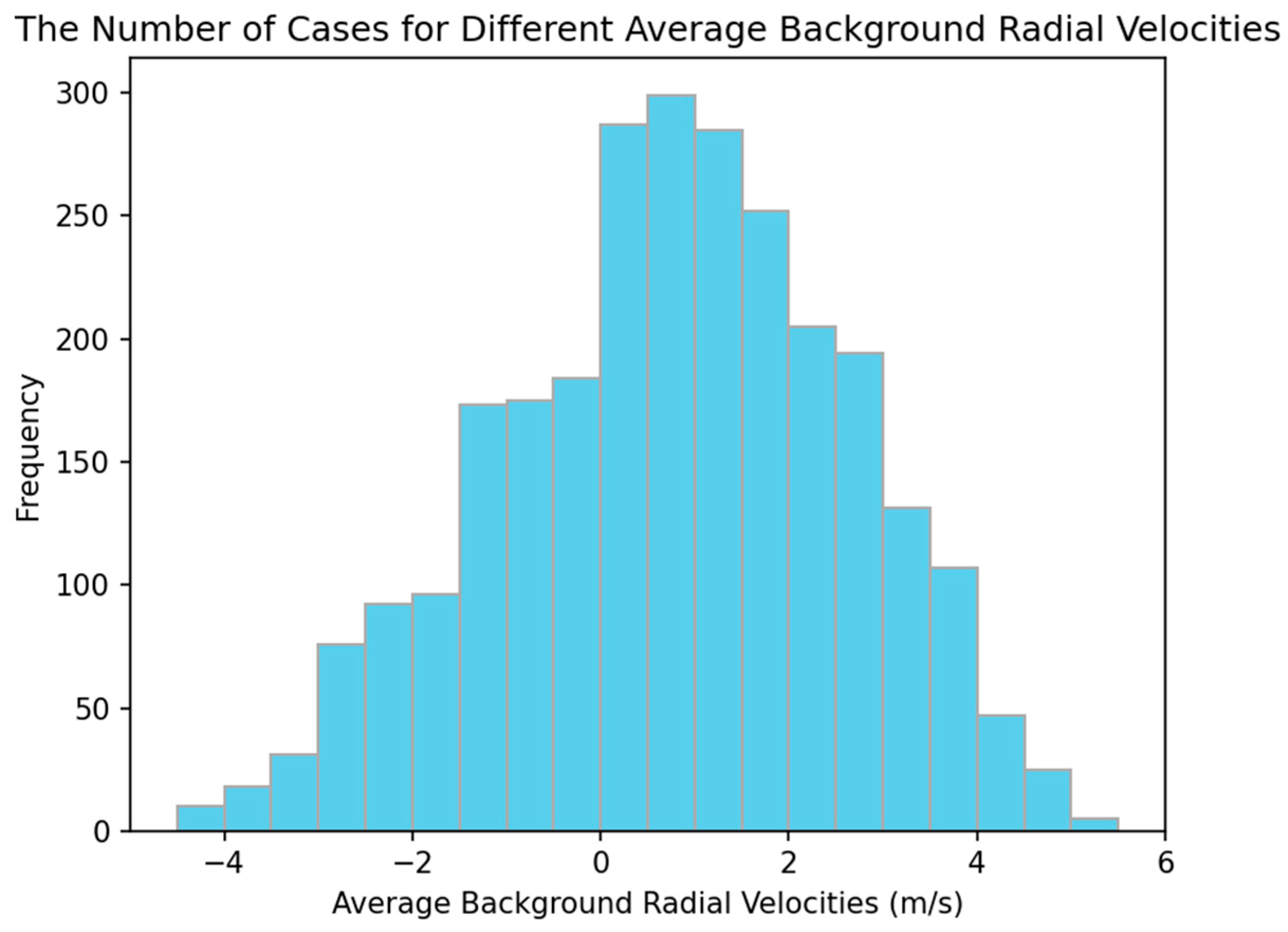
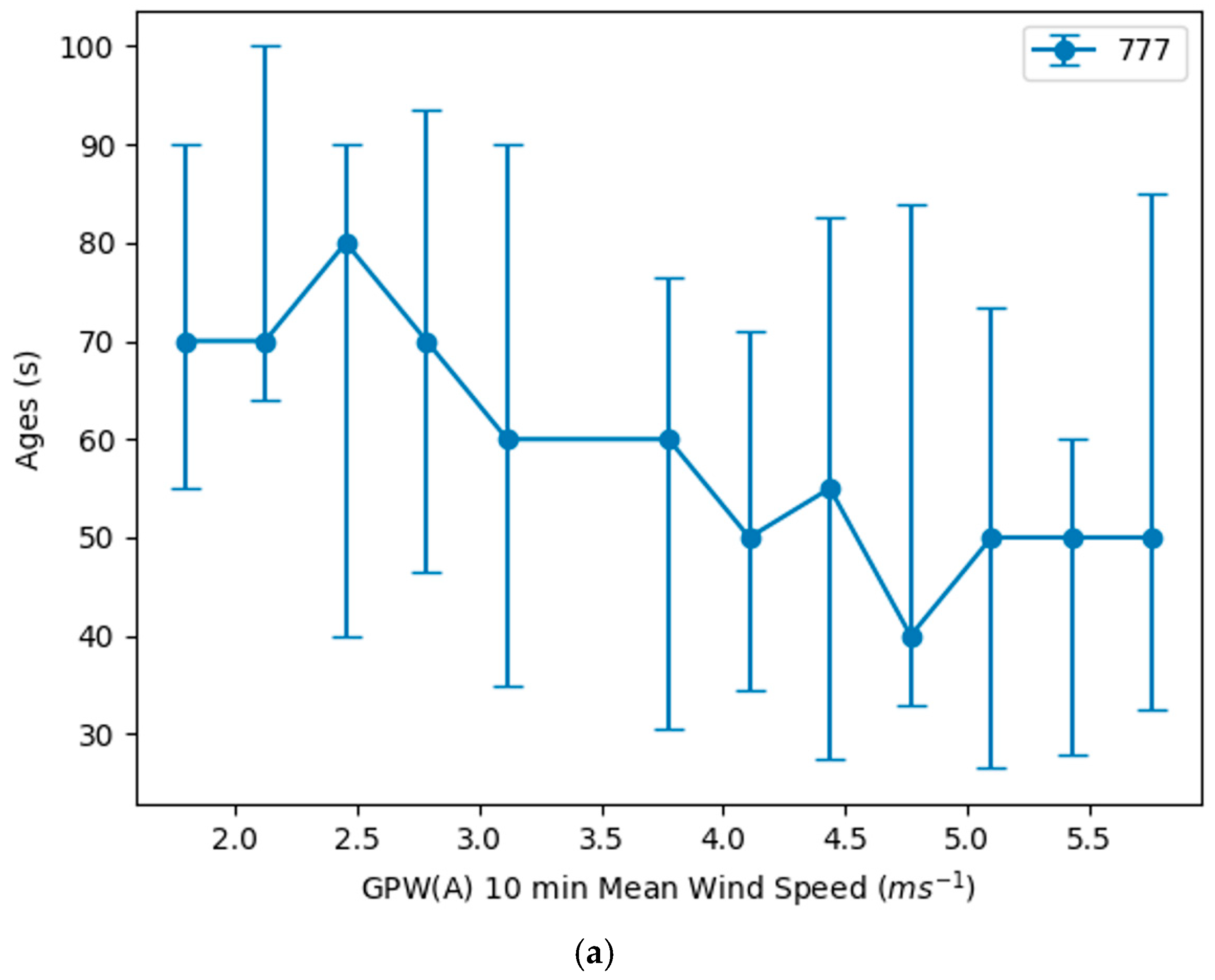

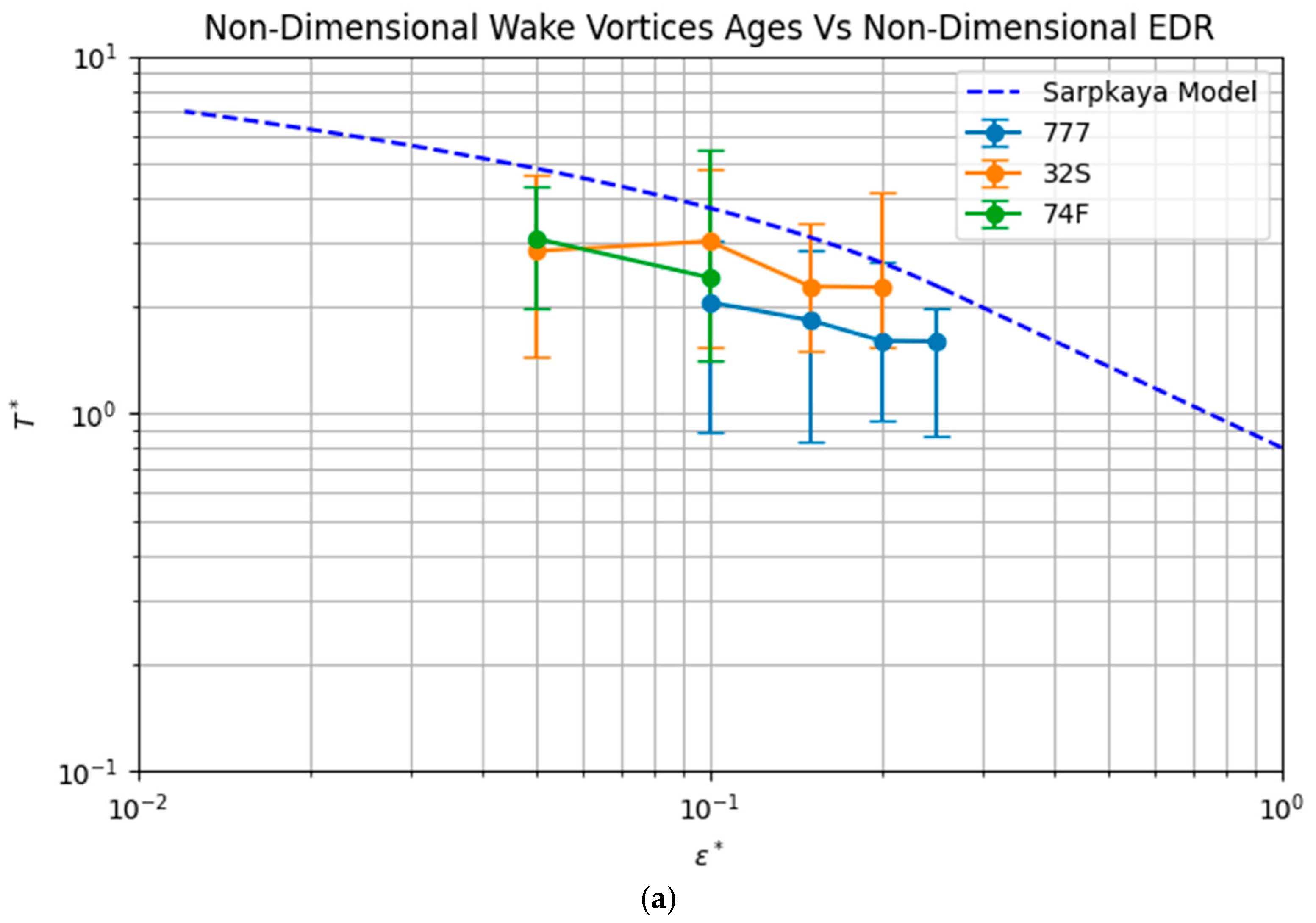

| Description | Specification |
|---|---|
| Location (Latitude, Longitude) | (22.3181 N, 113.8815 E) |
| Scanning mode | Range–height indicator (RHI) |
| Radial range | 3000 m |
| Gate length | 12 m |
| Doppler range | 38.0 to −38.0 ms−1 |
| Resolution | 0.1 ms−1 (approx.) |
| Scanning rate | 10 s/scan |
| Azimuthal angle | 340° |
| Elevation angle | 19° to −1° |
| Angular resolution | 0.5° (approx. 40 rays/frame) |
| Manufacturer | HALO Photonics, Lumibird Group |
| Model | Streamline XR |
| Factors | Correlation | |
|---|---|---|
| r | p-Value | |
| Background radial velocity in the SR-LIDAR scan | −0.097 | 0.000 |
| Maximum radial velocity difference between extrema of vortices and background radial velocity | −0.247 | 0.000 |
| Relative humidity | 0.092 | 0.106 |
| Instability | −0.033 | 0.437 |
| Wingspan | −0.015 | 0.452 |
| Initial circulation | 0.159 | 0.000 |
| Hour of the day | 0.004 | 0.827 |
Disclaimer/Publisher’s Note: The statements, opinions and data contained in all publications are solely those of the individual author(s) and contributor(s) and not of MDPI and/or the editor(s). MDPI and/or the editor(s) disclaim responsibility for any injury to people or property resulting from any ideas, methods, instructions or products referred to in the content. |
© 2025 by the authors. Licensee MDPI, Basel, Switzerland. This article is an open access article distributed under the terms and conditions of the Creative Commons Attribution (CC BY) license (https://creativecommons.org/licenses/by/4.0/).
Share and Cite
Shiu, T.-K.; Ngai, L.-Y.; Cheung, P.; Chan, P.-W. A Study of Aircraft Wake Vortices at Hong Kong International Airport Using Short-Range LIDAR. Appl. Sci. 2025, 15, 12466. https://doi.org/10.3390/app152312466
Shiu T-K, Ngai L-Y, Cheung P, Chan P-W. A Study of Aircraft Wake Vortices at Hong Kong International Airport Using Short-Range LIDAR. Applied Sciences. 2025; 15(23):12466. https://doi.org/10.3390/app152312466
Chicago/Turabian StyleShiu, Tsui-Kwan, Lee-Yeung Ngai, Ping Cheung, and Pak-Wai Chan. 2025. "A Study of Aircraft Wake Vortices at Hong Kong International Airport Using Short-Range LIDAR" Applied Sciences 15, no. 23: 12466. https://doi.org/10.3390/app152312466
APA StyleShiu, T.-K., Ngai, L.-Y., Cheung, P., & Chan, P.-W. (2025). A Study of Aircraft Wake Vortices at Hong Kong International Airport Using Short-Range LIDAR. Applied Sciences, 15(23), 12466. https://doi.org/10.3390/app152312466







